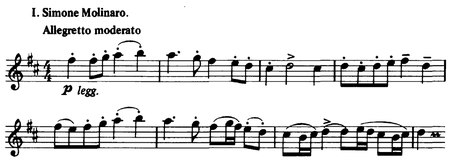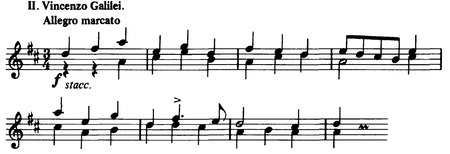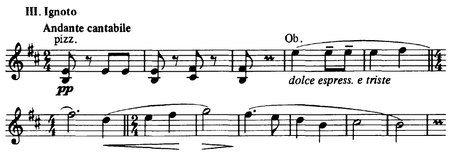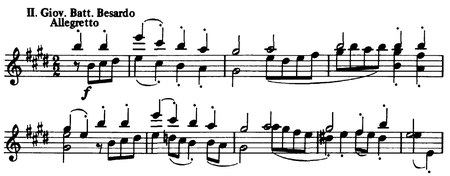Top Qs
Timeline
Chat
Perspective
Ancient Airs and Dances
Three orchestral suites by Ottorino Respighi From Wikipedia, the free encyclopedia
Remove ads
Ancient Airs and Dances (Italian: Antiche danze ed arie) is a set of three orchestral suites by Italian composer Ottorino Respighi, freely transcribed from original pieces for lute. In addition to being a renowned composer and conductor, Respighi was also a notable musicologist. His interest in music of the Renaissance and Baroque periods led him to compose works inspired by the music of these periods.
This article needs additional citations for verification. (February 2022) |
Remove ads
Suite No. 1 (1917)
Suite No. 1 P 109 was composed in 1917. It was based on Renaissance lute pieces by Simone Molinaro, Vincenzo Galilei (father of Galileo Galilei) and additional anonymous composers.
- Balletto: "Il Conte Orlando" (Simone Molinaro, 1599)
- Gagliarda (Vincenzo Galilei, 1550s)
- Villanella (anonymous, end of 16th century)
- Passo mezzo e mascherada (anonymous, end of 16th century)
The orchestration calls for 2 flutes, 2 oboes, English horn, 2 bassoons, 2 horns in F, trumpet in D, harp, harpsichord and strings.
Remove ads
Suite No. 2 (1923)
Suite No. 2, P 138 was composed in 1923. It was based on pieces for lute, archlute, and viol by Fabritio Caroso, Jean-Baptiste Besard, Bernardo Gianoncelli, and an anonymous composer. It also includes an aria attributed to Marin Mersenne.
- Laura soave: balletto con gagliarda, saltarello e canario (Fabritio Caroso)
- Danza rustica (Jean-Baptiste Besard)
- Campanae parisienses (anonymous) & Aria (attributed to Marin Mersenne)
- Bergamasca (Bernardo Gianoncelli, 1650)
The orchestration calls for an average-sized orchestra of 3 flutes (3rd doubling piccolo), 2 oboes, English horn, 2 clarinets in A/B♭, 2 bassoons, 3 horns in D (doubling 2 horns in E/F), 2 trumpets in A/D (doubling trumpet in C), 3 trombones, 3 timpani, celesta, harpsichord 4-hands, harp and strings.
Remove ads
Suite No. 3 (1931)
Suite No. 3, P 172 was composed in 1931. It differs from the previous two suites in that it is arranged for strings only and somewhat melancholy in overall mood. (A note by the composer in the printed score states that the work may also be performed by a string quartet, completely omitting the double-bass part.) It is based on lute songs by Besard, a piece for Baroque guitar by Ludovico Roncalli, and lute pieces by Santino Garsi da Parma and additional anonymous composers.
- Italiana (Anonymous: Italiana (Fine sec. XVI) – Andantino)
- Arie di corte (Jean-Baptiste Besard: Arie di corte (Sec. XVI) – Andante cantabile – Allegretto – Vivace – Lento con grande espressione – Allegro vivace – Vivacissimo – Andante cantabile)
- Siciliana (Anonymous: Siciliana (Fine sec. XVI) – Andantino)
- Passacaglia (Lodovico Roncalli: Passacaglia (1692) – Maestoso – Vivace)
Transcriptions
The Ancient Airs and Dances first two suites were freely transcribed by the composer for piano (2 and 4 hands).[citation needed] In 2016, Dennis Janzer transcribed the set for the organ.[1]
Recordings
There have been many recordings of the suites in their entirety, and individually, with Suite No. 3 most frequently appearing alone. Recordings include:
- Philharmonia Hungarica, Antal Dorati (Mercury)
- Boston Symphony Orchestra, Seiji Ozawa (DG)
- Los Angeles Chamber Orchestra, Sir Neville Marriner (EMI)
- Lausanne Chamber Orchestra, Jesús López-Cobos (Telarc)
- Saint Paul Chamber Orchestra, Hugh Wolff (Teldec)
- Australian Chamber Orchestra, Christopher Lyndon-Gee (Omega)
- Sinfonia 21, Richard Hickox (Chandos)
- Orpheus Chamber Orchestra (1 & 3 only) (DG)
- Rome Symphony Orchestra, Francesco La Vecchia
- Orchestre Philharmonique de Liège, John Neschling (BIS)
In 1987 Paul O'Dette released a recording of the original lute songs and dances on which Respighi based the suites.
Suite No. 3 only
- Berliner Philharmoniker, Herbert von Karajan (DG)
- I Musici
- I Solisti Italiani
- Academy of St. Martin-in-the-Fields, Sir Neville Marriner (Philips)
- English String Orchestra, William Boughton (Nimbus)
Remove ads
References
External links
Wikiwand - on
Seamless Wikipedia browsing. On steroids.
Remove ads












